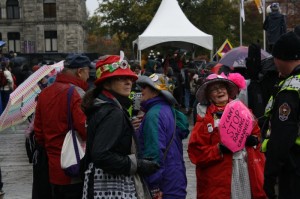On October 22, thousands of opponents of pipelines, tar sands, and oil tankers gathered together at the Legislature in an act of civil resistance dubbed Save our Coast.
The day was filled with inspired speeches, live music, enlightening discussions, and a sense of camaraderie that seemed to cover the crowd. People from all walks of life were present at the event: politicians, Aboriginal leaders, grannies, toddlers, students.

While one of the major objections to the proposed Enbridge pipeline is the environmental damage it could cause, there was also a distinct focus on indigenous land rights at Save our Coast.
Green party leader Elizabeth May also brought to light the negative repercussions of the Canada-China Investment Treaty, with regards to such things as the right for China to be able to claim damages over Canadian laws, and how we may even be restricted on the use of our own resources.
The event officially started at 11 am on that day, but movements have been happening since then, with advocates of the cause across Canada rallying outside the offices of their local MLAs. Social media also played a large role in spreading awareness, and the event even became the number-one trend on Twitter for a period.
One important goal of the event was an emphasis on it being a peaceful resistance, and, through the cooperation of protesters and the support of local police, this, regardless of whether or not the pipeline gets built, was a success.
